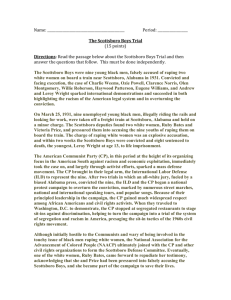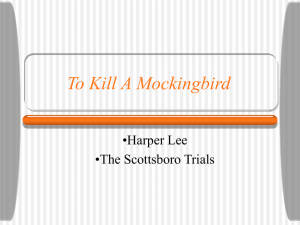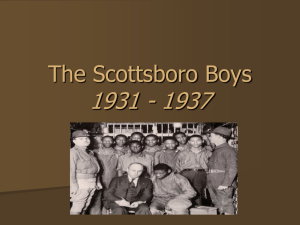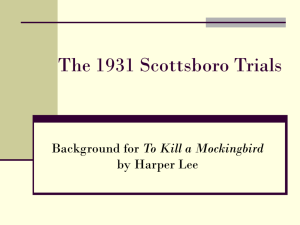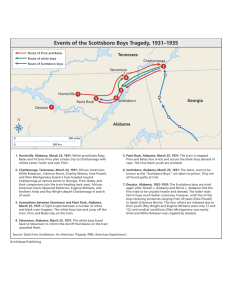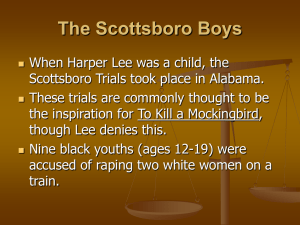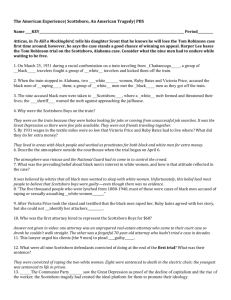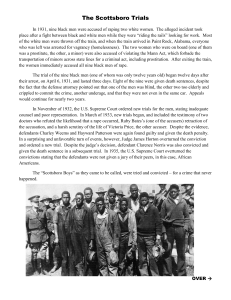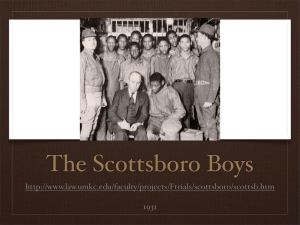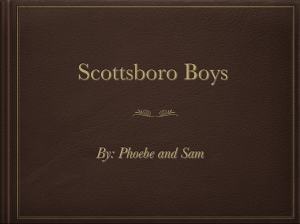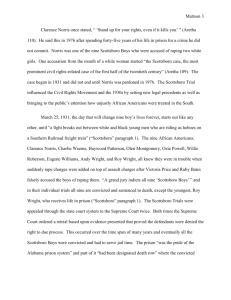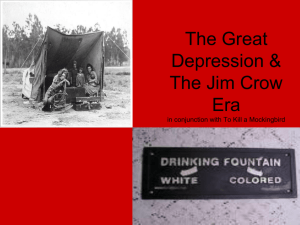Students in First year Seminar 27/28, Professor Linda Humes
advertisement
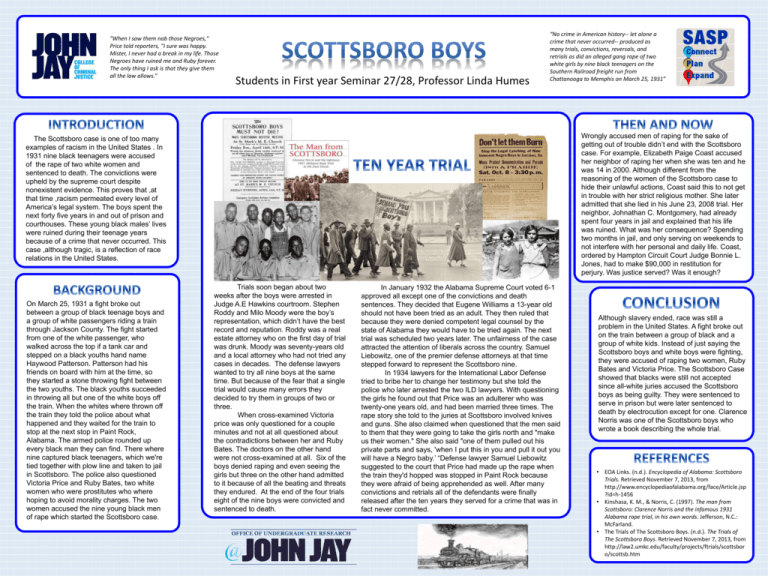
"When I saw them nab those Negroes," Price told reporters, "I sure was happy. Mister, I never had a break in my life. Those Negroes have ruined me and Ruby forever. The only thing I ask is that they give them all the law allows.” Students in First year Seminar 27/28, Professor Linda Humes “No crime in American history-- let alone a crime that never occurred-- produced as many trials, convictions, reversals, and retrials as did an alleged gang rape of two white girls by nine black teenagers on the Southern Railroad freight run from Chattanooga to Memphis on March 25, 1931” Wrongly accused men of raping for the sake of getting out of trouble didn’t end with the Scottsboro case. For example, Elizabeth Paige Coast accused her neighbor of raping her when she was ten and he was 14 in 2000. Although different from the reasoning of the women of the Scottsboro case to hide their unlawful actions, Coast said this to not get in trouble with her strict religious mother. She later admitted that she lied in his June 23, 2008 trial. Her neighbor, Johnathan C. Montgomery, had already spent four years in jail and explained that his life was ruined. What was her consequence? Spending two months in jail, and only serving on weekends to not interfere with her personal and daily life. Coast, ordered by Hampton Circuit Court Judge Bonnie L. Jones, had to make $90,000 in restitution for perjury. Was justice served? Was it enough? The Scottsboro case is one of too many examples of racism in the United States . In 1931 nine black teenagers were accused of the rape of two white women and sentenced to death. The convictions were upheld by the supreme court despite nonexistent evidence. This proves that ,at that time ,racism permeated every level of America’s legal system. The boys spent the next forty five years in and out of prison and courthouses. These young black males’ lives were ruined during their teenage years because of a crime that never occurred. This case ,although tragic, is a reflection of race relations in the United States. On March 25, 1931 a fight broke out between a group of black teenage boys and a group of white passengers riding a train through Jackson County. The fight started from one of the white passenger, who walked across the top if a tank car and stepped on a black youths hand name Haywood Patterson. Patterson had his friends on board with him at the time, so they started a stone throwing fight between the two youths. The black youths succeeded in throwing all but one of the white boys off the train. When the whites where thrown off the train they told the police about what happened and they waited for the train to stop at the next stop in Paint Rock, Alabama. The armed police rounded up every black man they can find. There where nine captured black teenagers, which we're tied together with plow line and taken to jail in Scottsboro. The police also questioned Victoria Price and Ruby Bates, two white women who were prostitutes who where hoping to avoid morality charges. The two women accused the nine young black men of rape which started the Scottsboro case. Trials soon began about two weeks after the boys were arrested in Judge A.E Hawkins courtroom. Stephen Roddy and Milo Moody were the boy’s representation, which didn’t have the best record and reputation. Roddy was a real estate attorney who on the first day of trial was drunk. Moody was seventy-years old and a local attorney who had not tried any cases in decades. The defense lawyers wanted to try all nine boys at the same time. But because of the fear that a single trial would cause many errors they decided to try them in groups of two or three. When cross-examined Victoria price was only questioned for a couple minutes and not at all questioned about the contradictions between her and Ruby Bates. The doctors on the other hand were not cross-examined at all. Six of the boys denied raping and even seeing the girls but three on the other hand admitted to it because of all the beating and threats they endured. At the end of the four trials eight of the nine boys were convicted and sentenced to death. In January 1932 the Alabama Supreme Court voted 6-1 approved all except one of the convictions and death sentences. They decided that Eugene Williams a 13-year old should not have been tried as an adult. They then ruled that because they were denied competent legal counsel by the state of Alabama they would have to be tried again. The next trial was scheduled two years later. The unfairness of the case attracted the attention of liberals across the country. Samuel Liebowitz, one of the premier defense attorneys at that time stepped forward to represent the Scottsboro nine. In 1934 lawyers for the International Labor Defense tried to bribe her to change her testimony but she told the police who later arrested the two ILD lawyers. With questioning the girls he found out that Price was an adulterer who was twenty-one years old, and had been married three times. The rape story she told to the juries at Scottsboro involved knives and guns. She also claimed when questioned that the men said to them that they were going to take the girls north and "make us their women." She also said "one of them pulled out his private parts and says, 'when I put this in you and pull it out you will have a Negro baby.’ “Defense lawyer Samuel Liebowitz suggested to the court that Price had made up the rape when the train they'd hopped was stopped in Paint Rock because they were afraid of being apprehended as well. After many convictions and retrials all of the defendants were finally released after the ten years they served for a crime that was in fact never committed. Although slavery ended, race was still a problem in the United States. A fight broke out on the train between a group of black and a group of white kids. Instead of just saying the Scottsboro boys and white boys were fighting, they were accused of raping two women, Ruby Bates and Victoria Price. The Scottsboro Case showed that blacks were still not accepted since all-white juries accused the Scottsboro boys as being guilty. They were sentenced to serve in prison but were later sentenced to death by electrocution except for one. Clarence Norris was one of the Scottsboro boys who wrote a book describing the whole trial. • EOA Links. (n.d.). Encyclopedia of Alabama: Scottsboro Trials. Retrieved November 7, 2013, from http://www.encyclopediaofalabama.org/face/Article.jsp ?id=h-1456 • Kinshasa, K. M., & Norris, C. (1997). The man from Scottsboro: Clarence Norris and the infamous 1931 Alabama rape trial, in his own words. Jefferson, N.C.: McFarland. • The Trials of The Scottsboro Boys. (n.d.). The Trials of The Scottsboro Boys. Retrieved November 7, 2013, from http://law2.umkc.edu/faculty/projects/ftrials/scottsbor o/scottsb.htm
